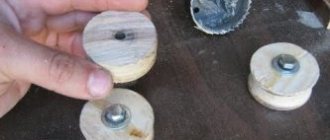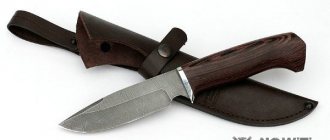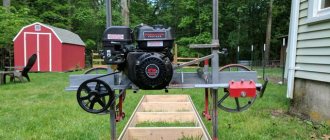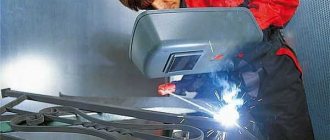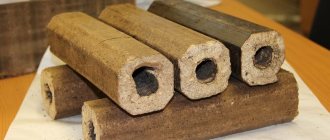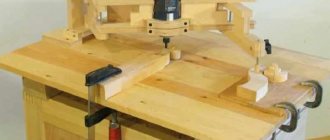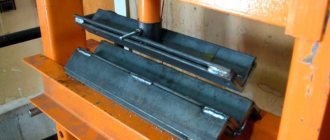Craftsmen are drinking. Excuse me, they are having a intimate conversation. For one, instead of the sacramental “Vasya, do you respect me?” “Vasya, how many hands would you like for yourself?” comes out of your mouth? He thinks about it: “How much? But who knows... Well, how much work is needed there..."
Hands, of course, to hold, press, pick up, etc. Therefore, such an auxiliary tool as temporary removable clamps of various types - clamps - is always lacking for a craftsman. There wasn’t enough at a time when these same clamps cost a penny. Nowadays they can charge more than 1000 rubles for a good clamp. Despite the fact that now even in small piece production, power tools, electric and gas welding, pressure gluing and other technologies that require reliable holding of parts during the working process are widespread. The purpose of this article is to tell the reader how to make a clamp with your own hands at home. Preferably - from scrap materials with minimal need for welding and turning work.
Note : in English, a clamp is cramp (screw), bar clamp (spring-lever) or simply clamp, similar to how a screwdriver (screw driver) is often called simply screw. A person who knows spoken English well, but is unfamiliar with the technical features (these are very different languages), hearing something like “Give me screw driver,” most likely will not understand what they want from him. Moreover, poorly educated English-language articles are most often “swallowed.” If you happen to find yourself in a similar situation, listen: “the screw” means a tool, and “a screw” means some kind of threaded hardware (screw, screw) that is twisted with it.
Varieties
The purpose of this publication is not to build something like an encyclopedia of mounting clamps - there are many types of them, and there are even more patents for new, “super-super” ones. Our task is to show which clamps are most needed in a home workshop, and how best to make a clamp without wasting a lot of material and time.
The most common types of clamps in handicraft production are shown in Fig:
- G-shaped (G-cramp; G-clamp) is the most reliable, reliable and cheapest of the general-purpose clamps. Disadvantages: it takes a long time to tighten and can turn the parts being glued if the stop hinge is of poor quality or not maintained. The latter is quite important: an adhesive layer that has not set is a good lubricant, but it is undesirable to separate and recompress the surfaces being glued together, as the strength of the dried joint decreases sharply. In addition, a regular G-clamp does not hold round parts well, so a special pipe clamp is used to secure pipes or a round profile for welding or butt soldering (see next figure). Assembled from ordinary structural steel s=(2.5-4) mm, such a welded clamp provides reliable fixation of pipes up to d(120-150)x(1.5-4) mm.
Clamp for welding and butt soldering of pipes - F-shaped (F-cramp). Quick-clamping, operates on the principle of jamming the sliding stop in the dead center position. Pressure until it is firmly secured is most often provided by a screw clamp, as in a G-shaped clamp. An even “softer” and faster clamping, but less reliable, is provided by a trigger-eccentric clamping mechanism, see below. The most versatile and widespread of the clamps. The main disadvantage is that due to vibrations and shocks during operation, it can self-unclip and release. Or, on the contrary, it jams tightly, and when wedged with a hammer blow (see below), either the clamp or the part “shoots out”. It is not suitable for adaptation to butt welding of pipes: the jaws are driven by indirect heating and the pipe joint moves apart.
- C-shaped (C-clamp, fixing tongs). A fairly narrowly specialized tool. The main purpose is to compress the parts to be glued. Simple C-clamps are made with a spring clamp. The trigger-lever clamp allows you to precisely set the clamping force.
- Angle clamps for welding linear parts (pipes, profiles) at a given angle. There is no completely established special Anglo-American term. The most commonly used are welding clamp and dead-lock clamp.
- Joiner's bench - a carpentry clamp for joining panels from boards, slats and beams, assembling units from shaped parts (for example, railings with balusters). On the trail. rice. a rail clamp is shown; There are also rack and pipe ones, see below. Please note that pipe clamps are sold under the name “pipe clamp”, and clamps for end-to-end welding/soldering of round timber should be searched for under the query “welded clamp”.
- E-shaped (E-clamp). A highly specialized tool for edging carpentry with glue. If you need to carefully glue an edge on existing valuable furniture/interior design, it is difficult to do without an E-clamp.
- O-shaped or tape, or crimp grip (loop stay, loop brace). Band clamps are most often used by virtuoso carpenters and furniture makers-restorers. If you can fetch up to $1000 or more for a well-restored antique Viennese chair, then for a slightly skewed or wobbly chair they will fetch, at best, 15-20 of the same ones. Making a frame for a large painting or photograph without a tape clamp is also not so easy.
- Lever-plunger (precision clamp). When the trigger is pressed, the plunger (pusher) with the clamping stop moves smoothly forward. The trigger is released - the plunger is fixed by a spring-loaded slide, which becomes in the dead center position. Pressing again releases the slide and further advances the plunger. A good lever-plunger clamp can securely clamp a chicken egg without damaging its shell. In a home workshop, such precision clamping is unlikely to be needed, but suddenly a good precision clamp can be obtained from a mounting gun for tubes with silicone, etc. viscous compounds. A fixed jaw can be easily installed into the opening (window) for the neck of the tube, and a movable one is mounted on the rod instead of the standard pusher. If necessary, both can be removed and the tool can be used for its intended purpose.
Simple DIY quick-release clamp
The first option is the most optimal for beginners. And that's where we'll start. You will need a welding machine, a grinder and a drill.
Quick-release locksmith clamps are very convenient to use, so we believe that every craftsman should have them. Moreover, making such a clamp is not so difficult.
Let's look at one of the simplest options. The idea itself belongs to the author of the YouTube channel Mr Tool Junction.
The main material is a metal strip. You will also need:
- old file;
- pipe;
- hardware.
As I already said, the basis of the homemade product is a metal strip. The author takes a workpiece 30 cm long, marks it and cuts it into two parts exactly in half. Or you can immediately cut two pieces of the required length from the strip (in this case, 15 cm each) or cut them from sheet metal of suitable thickness.
Next, we will need another piece of metal strip about 25-30 cm long (the length of the workpiece is at your discretion).
All three prepared parts must be connected together. We place the short pieces parallel to each other and weld them perpendicular to the long piece of strip.
As a result, we will get one of the main parts of the homemade product - the frame of the homemade clamp. Using an angle grinder, cut a groove in its long part.
Next, you will need to make a stationary clamping jaw of the clamp. To do this, the author cuts a piece from an old flat metal file. We weld the workpiece to the frame.
At the next stage, we proceed to the manufacture of the moving part of the clamp - a block with a quick-clamping mechanism.
We cut two parts (metal strips) of the same length, and weld a piece of the same strip to their ends. After this, we clean the place where the parts meet with a flap wheel for an angle grinder.
The craftsman drills a pair of coaxial holes in the resulting part. You will also need to weld the nut, as shown in the photo below.
Now you need to make a movable pressure jaw. We cut off the workpiece and cut out a groove with a grinder or Dremel so that the resulting part can be inserted into the nut.
In the moving part, we drill an additional couple of holes, which are needed to attach this part to the frame of a homemade quick-release device.
At the end, all that remains is to make a lever with which the pressure jaw will be pressed against the workpiece.
To do this we need a small piece of metal strip and a piece of round steel pipe. The edge of the strip must be rounded. We also drill a hole in it. We insert the workpiece into the pipe and scald it.
Next we proceed to assembly. We attach the moving part to the frame using a bolt with a wing nut. Install the lever.
If desired, the homemade product can be additionally painted - I think that it is much more pleasant to work with a beautiful and well-maintained tool.
You can watch the author's video for more information on how to make a clamp with a quick clamp.
GENIUS IDEA!
Among the advantages of this design, it is worth noting the ease of manufacture (even novice craftsmen can make such a clamp for themselves), as well as low cost - all the necessary components can be found in scrap metal.
How to do which
Any of the clamps described above can be made independently in a home workshop. Carpentry clamps are made of metal - the wooden frame and jaws of the tool will not withstand the back pressure of the material of the part(s), the clamp will weaken during operation, and the clamp itself will become unusable. With welded and soldered clamps it’s already clear: only metal; wood is a flammable material.
Carpentry clamps for working with valuable wood or products are best made of wood, but you can also use metal ones with spacers made of plywood or even shingles. It is better to use wooden clamps for gluing into a layer (on thick workpieces from several thin ones), even if metal or plastic is being glued - wooden jaws provide a more uniform distribution of pressure over the plane and, accordingly, better gluing quality. Fragile parts (glass, etc.) are compressed for gluing only with wooden clamps.
Clamp in the shape of the letter F
These options can be either metal or wood, and in their shape they are similar to calipers. It’s still not difficult to make such a clamp. It is recommended to use durable wood or metal as the material.
It is necessary to make small cuts in the rail so that moving parts can be fixed. Your workpieces are secured using a holder that is adjustable thanks to nuts. If the holder is loosened, the workpiece can be easily removed from the clamp.
Note!
Do-it-yourself compressor: selection of materials and tools for assembly at home + step-by-step instructions for making and assembling yourselfHomemade products for the garage with your own hands: options for products for arranging a garage, detailed diagrams and drawings for creating with your own hands
- Do-it-yourself press - design features, choice of manufacturing materials. Step-by-step instructions for making it yourself + simple diagrams and drawings
G-shaped
The frames of factory-produced G-clamps are cast. It is impossible to organize a steel foundry in a garage or barn, even in a forge on your own property. Since G-clamps, being the most “graspy” ones, are used mainly in metalworking and welding work with rather long and/or heavy parts, a homemade G-shaped clamp must be made of welded or solid metal.
Craftsmen often weld themselves clamps from sheet steel, pos. 1 in Fig.:
Homemade G-Clamps
Apparently, copying the profile of the frames of factory products, which in this case is incorrect. Profiles of cast frames of clamps are shown in pos. 2. Pay attention to the fairings and fillets (shown by arrows). Smoothing the profile is necessary to avoid the concentration of mechanical stress: they “love” corners and crevices, like bed bugs. But the weld does not work like a fillet! No, the clamp most likely will not break or bend. However, the recoil of the clamped part will move the frame a little, and it will be difficult to achieve precise fixation, and it is possible that the part may rotate when the clamp is tightened.
Homemade clamps made from channel sections are quite reliable (item 3). Disadvantages: labor-intensive, disproportionately heavy compared to the working width. You can cut a channel into clamp frames if you need to compress the parts very tightly. The best option for clamp frames for normal work is made from a square profile pipe, pos. 4. Depending on the size and wall thickness of the workpiece, clamps from corrugated pipe can be made for a working width of up to 1 m or more, see video:
Video: clamps from a profile pipe
Note: for the manufacture of the most important unit of the G-clamp - the screw clamp - see the end, since it is also used in other types of clamps.
G.E.
A type of G-clamp is a clamping one, which could roughly be called a GE-clamp. Clamps are well known to builders of small wooden boats, but they will also be very useful in small wooden construction (for example, a country or frame house, outbuilding, etc.).
Drawings of the clamping clamp and the method of their use are shown in the figure:
Drawings and procedure for using clamping clamps
For example, when sewing, say, a crossbar (truss structure) of a roof, each subsequent board is first pressed tightly against the previous one, and then attached to the rafter beams. Accordingly, the reliability and durability of the entire roofing pie are greatly increased.
The principle of operation of the clamp
Mechanics, carpenters, mechanics and others encounter clamps while still studying at school - during technology lessons. Clamps are easy to make with your own hands and are needed to secure various parts made of wood or metal. They are secured in a vice and then processed or cut.
In the past, this device could not completely free the master's hands, and he had to hold an ancient clamp. Nowadays, everything is much simpler: clamps are not only quick and easy to use, but also the principle of their operation is clear and easy to repeat. There are even quick-release clamps that you can easily make with your own hands.
The basis of a modern clamp is both a screw mechanism and a lever mechanism.
Thanks to the latter type, it is possible to quickly and easily fix the workpiece in a certain position without tedious, repetitive movements, because everything works thanks to simple physical laws and levers. They are called "quick clamps". They are simple and straightforward to make, and can be easily made right at home.
It is worth noting that thanks to such devices you can calculate how strong the pressure exerted on the workpiece will be. This is important if you do not want to damage the wood texture or leave dents on the part.
Note!
- Do-it-yourself winch: classification, manufacturing materials, description of work stages + instructions for DIY construction
DIY knife | A step-by-step description of how and from what materials to make a homemade knife
DIY vices: simple and reliable homemade vices from A to Z (190 photos)
Other varieties differ only in that the blanks are secured in them differently.
F-shaped
The device of the F-clamp, so to speak, in its entirety, is shown in the following. rice.:
F-clamp device
During use, the shoe is moved along the guide until the heel touches the part. Then with your thumb you move the pawl or press it (depending on the design of the latch), and the shoe becomes wedged on the guide. Then the part is pressed by turning the handle of the screw clamp, or by retracting the trigger of the eccentric clamp. Unfastening and unclenching - in reverse order.
There is no particular point in installing a complex locking mechanism in a homemade F-clamp. Then, to jam the shoe, press on its inner butt, or lightly hit it with a light hammer if the clamp is powerful and wide-grip. As a rule, the slide self-weeds itself when the screw is unclamped or the trigger is thrown into the socket. If the shoe is jammed, wedge it with a light blow to the outer butt from the side of the stop (in the direction opposite to the jamming one).
Left on the trail. rice. Drawings of a quick-release F-clamp with wooden jaws are given. In the center is the appearance of the tool, and on the right is the procedure for using it. Dimensions are converted from inch; they may be rounded to the nearest whole mm.
Drawings, appearance and procedure for using an F-clamp with wooden jaws
The main purpose of this clamp is clamping when gluing into a layer. The preferred sponge material is maple, elm, hornbeam, beech, oak or other wood that combines high strength and toughness; For example, the thrust combs of jointing and copying machines for wood are made from such wood. For other options for homemade quick-release clamps, see the video selection:
Video: homemade F-shaped clamp
Video: eccentric clamp
Video: quick clamp - DIY clamp
The design and principle of operation of the clamp
A clamp is one of the most useful tools in any workshop because it can be used for a variety of purposes. Its main function is to securely fix the product on a workbench or other reliable supporting structure. According to the drawing, the clamp must contain at least 2 parts in the design.
Clamps can be from the smallest to the largest sizes, in which case you will have the opportunity to reliably fix a part of any size before starting processing.
Attention! In addition to the supporting part, this device has a movable lip, which is always equipped with a fastening mechanism.
To make the sponge move, the design has a special lever or screw. They allow you to increase the force transmitted during fixation, thus preventing possible detachment of the clamp during its use.
Corner welds
The corner clamp for welding work must be entirely metal. High accuracy of fixation of parts and stability (stability) of their positioning are not required in this case: welding is not a precision work, and a couple of clamps are enough so that the clamp can be removed and welded without it. But the clamp must be applied (or inserted into it) on round and profile pipes, as well as on solid profiled long pieces. A “gentle” clamp is also useless.
Based on these considerations, the best material for the frame of a welding clamp is a steel angle with a thickness of 3 mm, pos. And in the figure:
Angle clamps for welding and soldering work on metal
Closing the corner into a triangle with a transverse tie will greatly increase the strength of the clamp, and by adding a couple more clamps to the crossbar, we get a clamp for welding at angles of 90 and 45 degrees, pos. B. The clamps are definitely screw: the eccentric, firstly, will not hold a heavy length; secondly, from heating during operation it can simply deteriorate.
Purpose
The corner clamp has become very widespread. In this case, the main purpose is only one - fixing the workpieces relative to each other. Among the features we note the following:
- When machining, reliable fixation must be carried out. Otherwise, there is a possibility of a significant reduction in the quality of the resulting surface.
- The angular design provides strong pressure and reliable fixation of the two elements when gluing them together.
The design of the clamp may differ slightly, it all depends on the specific case. When fixing fragile materials, an elastic gasket is used, which eliminates the possibility of damage to the surface layer.
Carpenter's pliers
Wooden temporary clamps are used in carpentry as widely as steel ones in plumbing and welding. Due to the characteristics of the main structural material, carpentry clamps are made almost exclusively C-shaped (pincer clamps).
The most powerful of the carpentry clamping devices is the alligator clamp, pos. 1 in Fig.:
Types of carpentry clamps
Sponges made of oak, elm, beech, hornbeam, walnut. Threaded pairs – from M12. Clamping parts with a crocodile is a troublesome task, so instead they often use an articulated screw C-clamp, pos. 2. Its “jaws” can be glued from plywood, and only the lining (“lips”) can be glued from durable wood. Instead of a shaped nut, it is possible to use a regular hexagonal nut, pressing it into the handle in a vice; in this case, the handle should be made of maple, beech or elm; oak may split when pressed.
Alligator clamps are used to securely hold fairly large and heavy parts. When gluing, you don’t need a strong clamp, but you need a lot of clamps, at least 3-4 per 1 linear meter. m glue joint. Therefore, carpentry clamps for gluing are most often made of plywood. Each “jaw” is glued together from 3 or another odd number of layers. In one of the “jaws” with a protrusion there will be a middle layer, and in the opposite one there will be two outer ones; In this way, and with the help of a steel pin, a hinge is formed. The clamp is spring (pos. 3 in the figure), and made from available elastic materials, pos. 4.
Cutting out and adjusting blanks of plywood crocodile clamps is a labor-intensive task, but the modern craftsman has at his disposal an excellent substitute - cuttings of large-diameter PVC pipes. A split ring made of pipe, a pair of wooden sticks, the same number of pieces of garden hose, and a clamp for pressing when gluing is ready, pos. 5. Cheap and cheerful. For more information about wooden clamps, see the videos:
Video: DIY wooden clamps
For the second, we advise you to go to YouTube and read the comments, there are tips on the case.
Carpenter's clamp for home workshop
The next type is carpentry clamps; we also recommend making them yourself. Usually carpenters work with this type, because it is intended for wood. This clamp will come in handy if you need to fasten wooden parts.
In the store you can find a large number of varieties of this product. Most of them may not suit your needs because they have different characteristics. There are no particular problems in the manufacture of this device, because it is simple and understandable.
It is easy to make this option from an old metal hacksaw, and an ordinary bolt is used as fasteners. You can choose the rest of the details for a do-it-yourself carpentry clamp at your discretion
The clamping width of the clamp is adjustable, so you can work with parts of different shapes and sizes without any problems, however, carpentry clamps are rarely used for any labor-intensive, heavy work.
Note!
Do-it-yourself vibrating table - selection of materials, components and assemblies for a vibrating table with a step-by-step manufacturing descriptionDo-it-yourself grain crusher - operating principle, types and features of creating a device for processing grain crops
- DIY concrete mixer | A visual aid on how and what to make a concrete mixer yourself
But like a vice, it’s unlikely to be attached to a workbench, but you can probably find a modified version on the Internet that will allow you to do this, so we advise you to look at the drawings for a carpentry clamp.
Vayms
Boards/slats/beams were assembled into shields by the carpenters of Ancient Egypt; By the way, they already knew a wood lathe. But if you look through carpentry manuals and promotional materials from 100-120 years ago, you will find that back then furniture for the poor was made from wood of a quality that would be elite in today’s times. And then, in orders for production (piece by piece) it is stipulated “as the material arrives.” This is the first. Secondly, tastes have changed. Today's ones make us remember the Rococo era - our contemporaries prefer something “natural”, pretentious; if possible - unique. Both circumstances could not but affect the designs of clamps - special carpentry clamps for gluing long lumber along the edges, which is bonding.
If you want to make, for example, a simple kitchen stool “like grandma’s”, and you have straight-layered boards for this, without knots or strands, then it is quite possible to get by with traditional homemade rim, pos. 1 and 2 in Fig.
Archaic (traditional) and modern vaymes
But if you are planning to build a shield like the one in Fig. 3 (and it’s beautiful, after all), then the clamping force will be needed an order of magnitude greater - after all, now the boards need to not only be pressed, but literally pressed into each other, and so that the entire assembly does not swell or turn out.
It is precisely this kind of unification that is carried out by modern Vimes. The rail clamp mentioned at the beginning is an expensive pleasure, and at least 5-6 of them are needed for a tabletop panel. Unfortunately, there is no equivalent homemade equivalent, but pipe and rack wedge stops (item 3) are sold and rented at reasonable prices. A sufficiently powerful rack wedge can be assembled on a section of steel profile pipe, pos. 4. If you need to quickly glue a couple of small boards into an edge, then a mini-frame for this can be built from an unusable hacksaw for metal, see next. rice.
Mini-weapon from a hacksaw
For other designs of homemade weims, see the story:
Video: do-it-yourself wires
Let's sum it up
In the process of woodworking, in most cases it is impossible to do without a carpentry clamp. Whether it is necessary to glue wooden blanks, secure a sheet, board, or slab during cutting - you will definitely need a clamp. There are similar products on sale, but, according to reviews from experienced craftsmen, they are characterized by two significant drawbacks - size limitations and low strength, since soft metals (alloys) are mainly used for their production in order to reduce costs.
Those who have to work with wood quite often prefer homemade carpentry clamps
How to make such a device with your own hands, what to pay attention to and take into account - this is discussed in the article
The author considers it advisable to dwell only on those that are most often used by “home craftsmen”. If the principle of their functioning becomes clear, then you will be able to make any type of carpentry clamp with your own hands, to suit your own needs. If, of course, you turn on your imagination and think carefully.
The author deliberately does not indicate the linear dimensions of the clamps. One of the advantages of making them yourself is the possibility of arbitrarily choosing the shape and dimensions of carpentry clamps. There is no standard for such devices. And it’s hardly advisable to “chew” basic things for a person who is used to (and knows how to) do everything with his own hands. The main thing is to give an idea, to “prompt an idea”, and everything else is at your own discretion.
Crimping grip
Band crimp clamps (crimp clamps, O-clamps) are rarely used by home craftsmen. But it’s not a technological circumstance that makes me remember them: 3,000 rubles. For a branded one it's still cheap. Meanwhile, an O-clamp that is no worse can be made with your own hands.
For this you will first need a flat textile sling and 4 swivels for it. The corner clamp, jaw and screw clamp slide are made of wood and fiberboard, on the left in Fig. The procedure for use has some peculiarities (by the way, the same applies to the most expensive branded ones).
Homemade crimping clamp for furniture and carpentry work
Let's say we need to assemble a series of identical photo frames. If they are different, the tool will have to be retooled for each. If not, then:
- The product parts are initially assembled dry, without glue.
- Lay it out on a plaz (flat plane) and use the marks on it to set 90 degree angles.
- Loop the slings and place the clamps in the corners.
- By moving the swivels, we achieve a weak, uniform tension on the branches of the sling (on the right in the figure).
- Gradually tighten the clamp, watching the corners of the product.
- If one of the corners diverges, then you need to apply a little sling in its direction, pulling it through the sotv. swivels.
- The adjustment of the crimping clamp is considered complete if it is possible to use a clamp to bring all the corner gaps “into a thread” - there is no need to turn the screw any more.
Now, if a series of products is being made, after gluing one screw, the screw is loosened, the next one is inserted (with glue in the corners), the clamp is tightened “to the threads,” etc.
Terms of use
There are several different rules regarding the use of the device. Among the features we note the following:
- Care must be taken to ensure that the surface is completely adjacent to the working part of the tool.
- When clamping, pay attention to the force applied. Too high an indicator causes damage to the surface layer.
- Do not forget that the corner clamp itself must also be securely fastened when machining the workpiece. Otherwise, the processing becomes significantly more complicated.
The simplicity of the mechanism means that it is quite easy to use. You don't need to have any special skills.
Screw clamp
The most unpleasant thing when using a clamp is if the washer (heel) gets stuck on the hinge and begins to rotate the part. The clamp then has to be removed and reinstalled, and the small part may break.
To avoid such a situation, the heels of factory-made clamps are placed on a ball stop, on the left in the figure:
Designs of screw clamps of clamps
Making it yourself is unrealistic: in addition to precision turning, you also need metal that combines high strength and toughness. Therefore, the clamping units of homemade clamps are most often made with cup-shaped ones under a screw with a washer (drawings on the right there). Such a clamp requires regular maintenance: the heel is rinsed in kerosene 2-3 times until the dregs of worn metal cease to stand out. Then add 2-3 drops of spindle, watch oil, etc. to the junction of the heel and the screw. liquid lubricant.
About carving
Threaded pairs of factory clamps, as you know, have a special thread - rectangular or trapezoidal with an increased pitch. A DIYer will most likely have to use a piece of threaded rod and a regular nut with a metric rolled thread. To prevent the clamp from jamming, you must, firstly, go through the nut with a second tap, respectively. standard size. If the thread is larger than M12, then use the second and third taps sequentially. The rod is similarly passed through with a die 2-3 times until the die (the die) starts to “run” freely along the thread when struck with a finger on the carrier of the driver. Secondly, the threaded pair must also be regularly wiped with a rag with kerosene and lubricated with any grease for machines and mechanisms.
Note : if a nut is welded onto the frame of a metal clamp, then the thread in it actually has to be cut anew - the original thread is strongly influenced by welding.
In conclusion, we give a video overview of various designs of clamping washers for homemade clamps:
Plywood device
One-time fixation, which does not require high rigidity, is successfully performed using sheets of plywood.
For work you will need pieces of plywood 1.5x10x10 cm, which are cut with a jigsaw. Squares are marked by dividing the blanks diagonally into two parts. Holes are marked at a distance of 20 cm from the edge with a distance between them of at least 8 cm, otherwise the clamps will begin to interfere with each other. Holes Ø40 mm are drilled in the marked places. Three corners are filed to remove excess glue under the clamps.
Cam clamp
This device is not only useful, but also extremely simple. It must be remembered that cam clamps are fast-acting, but cannot guarantee high clamping force on parts. That's why they are used when relatively little cutting force is required. They are not suitable for working under high pressure, as is possible with a large clamp. But at the same time they are extremely easy to use.
A special template is used for preparation. It is needed to create curves. The template is made of metal, plastic or wood. It is used to tighten smooth curves. However, the cam mechanisms do not directly follow the French curve. The correct cam should have a profile that increases the distance between the axis of rotation and constant speed. In this way it resembles a spiral drawn with a pencil.

